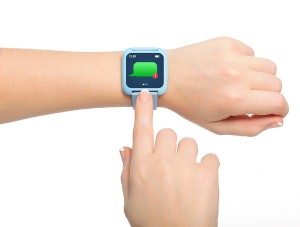The iWatch is likely the most feature rich electronics device ever planned, if one heeds the amazingly confident predictions that many analysts make regarding Apple Inc.’s (NASDAQ:AAPL) smartwatch. This is all the more remarkable because nobody from the Cupertino electronics firm has confirmed that the iWatch exists in prototype or is even planned. Instead, analysts infer the product’s impending arrival because of two separate factors – Tim Cook’s verbal expression of interest in smartwatches, and Apple Inc.’s hiring of health and fitness experts.
From these small acorns of fact, a mighty oak of rumor and imagination has sprouted. Korean news sources confidently assert that 65 million iWatches are being manufactured at this very moment – a rollout immensely larger than any of Apple’s (AAPL) most successful products to date. Apparently sober analysts show schoolboy enthusiasm in making up amazing features that the entirely speculative iWatch is “certain” to have.
 One of the latest of these is from Blayne Curtis of Barclay’s, who claims with remarkable conviction that the iWatch will feature a digital ultraviolet sensor that will somehow monitor the whole body for sunburn. This guess is based on the fact that Silicon Labs of Austin, Texas has developed new digital ultraviolet index sensors. The sensors are indeed small enough to fit in a wristwatch, measuring 2 millimeters square, and come in several different versions. These include motion sensing, 2D gesture sensing, and 3D gesture sensing variants.
One of the latest of these is from Blayne Curtis of Barclay’s, who claims with remarkable conviction that the iWatch will feature a digital ultraviolet sensor that will somehow monitor the whole body for sunburn. This guess is based on the fact that Silicon Labs of Austin, Texas has developed new digital ultraviolet index sensors. The sensors are indeed small enough to fit in a wristwatch, measuring 2 millimeters square, and come in several different versions. These include motion sensing, 2D gesture sensing, and 3D gesture sensing variants.
Though the Silicon Labs sensors would make a good addition to the iWatch, if it exists and if it is meant to be a health and fitness device, there is nothing to indicate that there is any connection between the sensors and the hypothetical smartwatch. There may indeed by iWatches currently in production, each fitted with digital UV index sensors, but there is no more objective evidence for this to be the case than there is that the iWatch does not and never will exist.
Apple Inc.’s (AAPL) opacity contributes to speculation like this, of course. In fact, it is possible that the Cupertino firm uses the rumor mill of modern Internet analysis as market research for potential products. It is not too difficult to imagine an anonymous Apple employee mentioning the name “iWatch” to an analyst and then letting the Internet “hive mind” run with the idea. Seeing what people say could give Apple a handle on whether the potential product is viable, and what features people would prefer to see (or not see).
There is no evidence for or against the idea that Apple (AAPL) starts rumors in order to see where they lead and how popular the potential product is. However, it would not be outside the realm of possibility, especially in a market where introducing a new product never seen before can be just as risky as not releasing new products at all. If Apple is looking for ideas about features to include in the iWatch, enthusiastic analysts are providing them with a nearly free windfall of ideas.



